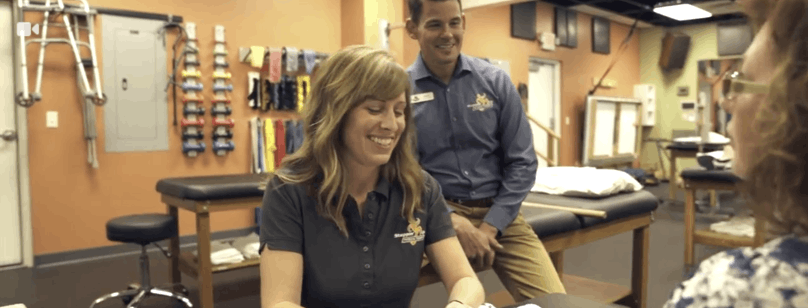Authority, credibility, expertise, and trust are all important factors that patients scrutinize when looking at a physical therapy website. Patients that are unable to develop a sense of trust with you as a physical therapy service provider are less likely to call or request time with you on your appointment request system.
Increase trust and you will increase new patients!
Here’s a quick list of credibility opportunities that you can implement to increase trust between you and potential patients.
In a Physical Therapy Practice, People Judge What They Can’t See Based on What They Can See
Fact is, in a service business, people can’t test drive you or try on your physical therapy services. An outdated website may leave an impression that your practice is out of touch and may not be a clinic of expertise or excellence. I have compiled a list of seventeen things you can do to improve your online appearance and help you successfully convey that you provide exceptional services:
1. Upgrade your website design:

Creating a new physical therapy website design is well within the budget of any practice. It is important for your website to look great on smartphones…so, a responsive website is the right choice. Don’t forget to test all your website’s marketing features on more than one type of smartphone. NOTE: E-rehab clients can get a new website, free of charge, every 3 years.
2. Take real photos of you, your staff, and your patients:
Don’t use stock photos…or at least not ones that look like stock photos. And never, ever use clip art! Hire a professional photographer to take some pictures for you or license unique images from a pro, and you’ll immediately upgrade the appearance of your site.
3. Update your font:
Studies have shown that your website font actually impacts the believability of the claims you make on your website. Font matters! Make sure you’re using fonts that are proven winners on the web and that are big enough to easily read.
4. Make it easy for patients to communicate with you:
With smartphones, apps, sms, email, chat, and social networks, there are many ways for patients to connect with your office. Don’t miss out on vital communications by ignoring some communications channels.
5. Make sure your phone number is on top and on every page:
Your phone number should be visible above the fold on every page of your website along with a click-to-call function when people visit your site on their smartphone.
6. Add a live chat option:
Adding a live chat option is easy (and free too!) with a system like tawk.to .
7. Don’t want the commitment of live chat; add a bot:

Chatbots are a popular way to automate the interactivity on your physical therapy website. With a physical therapy chatbot, you can answer many of the questions that your patients may have before they even come in to see you. It’s a great way to educate your patients and it’s a great place for patients to submit an appointment request as well. We find that 1 in 10 people that use an E-rehab Physical Therapy Chatbot are scheduling an appointment.
8. Make sure you have a map that’s easy to access:
Make sure your address(es) is easy to see. There’s nothing more frustrating than looking up a local practice only to find that you don’t know where they are located. Make sure you have your address permanently placed on your site above the fold and also have a Google Map available.
9. Leverage your great service:
I rarely meet a practice owner that doesn’t think they provide great service. Fact is, if a practice has been around for five or more years, they’re probably right. If they weren’t providing great service, they would have gone out of business. But here’s the problem; it doesn’t matter how much YOU tell others that you have a great practice, that you are the best, that you are number one…it will never be as effective as the social proof that other patients can and will share about your practice. Encourage your happy patients to share the word about the success they had with you.
10. Include patient ratings and reviews:

I’m going to spend a little extra time on this by leading with a question. If you were a consumer that needed a locksmith, an urgent care practice, emergency plumber, orthopedist, or a physical therapist, would you look for one on Facebook, Instagram, Snapchat, or Twitter? Out of the literally hundreds I have asked, I’ve only had one person say yes. Another couple said they might ask for a referral from Facebook. My point is, and your web stats will prove this to you, people check PT practices out online, most of the time, by either Googling you, or by going directly to your website. You may be asking, “What’s your point Dave?” My point is that there are two places that you want to have your ratings and reviews for prospective new patients; on Google and on your website. Start by getting ratings and reviews on those two platforms (and in most cases, it won’t matter if you have reviews anywhere else).
NOTE: Of course, this is how the E-rehab system works – we help practices capture ratings and reviews to be displayed on Google or your website. We also will import Google reviews and post them on your website as well.
11. Add patient video testimonials:

If a picture is worth a thousand words, then a video must be worth millions. If you have a bunch of positive ratings & reviews, undoubtedly, some will question their authenticity. You can avoid any doubt and demonstrate the happiness and satisfaction of your patients with video testimonials. Click here to see an example.
NOTE: We have a patient video testimonial system that is so fast and easy to use, anyone can use it. Contact me and I’ll show you that it’s as simple as it gets and there isn’t any emailing or uploading of videos.
12. Highlight your specialties:
If you offer services that are uncommon, such as aquatic therapy, women’s health, vestibular rehab, concussion treatment, etc., make sure that you have a dedicated web page about these services. Also make sure that you include the service and your city in the page title and body so it’s more likely to rank on Google.
13. Highlight professional awards and association affiliations:
Have you won a Top Rated or Best Of award? Make sure that you display the badge on your website. While most of these “best of” websites have no relevant criteria to judge the quality of a practice, they do give badges away to many practices. Why do they do this? They want you to put the badge on your website that links to them so they will rank better in the search engines for industry searches like “best physical therapy in Salt Lake City” or “top physical therapy clinic in New Orleans”. Yes, it’s a joke/game, but if you are lucky enough to get the arbitrary award, add it to your website. It can’t hurt. I do recommend that you simply add the image but don’t link back to the ratings and review site.
14. Personalize your website:
Today’s patients want to see who will be treating them. Here’s how you can add a personal touch to the experience:
Staff biographies
Make sure that you have updated staff biographies on your website. Include the schools that staff member attended, certifications, specialized con-ed, types of patient conditions they like to treat, and then humanize the staffer. Tell viewers what they like to do in their spare time, mention some details about family, and involvement in the community if it’s relevant.
Behind-the-scenes

By providing video and pictures to show viewers what happens at the practice, a patient can more easily visualize their own visit. You may also want to showcase any unique company cultural traits. Both of these will result in impressing to the patient that your physical therapy practice is relatable and trustworthy.
Pictures of your great service
We are frequently asked what kinds of pictures should be on a physical therapy website. I suggest you share images of what you do best…patient education, manual therapy, and the sophisticated therapeutic exercises/neuromuscular reeducation that you use every day. For various services pages, take specific photos of the above three categories and include them on the respective services pages.
15. Be a healthcare professional:
A lot of the tips above are designed to make your business feel more relatable and friendly. But when it comes to opening up their wallets, customers still want to know you are a clinical professional. Here are ways to show you mean business:
Have a secure domain
This is a big one! Invest in an SSL certificate and secure your domain. It will help with SEO, build viewer trust, and HTTPS 2.0 protocols can speed up your site too.
Make sure you address the payment, billing, and co-insurance payment processes on your website
Show that you stand behind your physical therapy services with confidence!
Make your Privacy Policy visible
Make it clear that you’re going to protect their valuable information.
16. Make it clear how to reach support:
Let them know how you will handle things when they go wrong. When it comes to healthcare services, most complaints are centered around money. Clearly communicating how you verify insurance benefits, how the billing process works, and communicating in a timely manner can go a long way toward building trust.
17. Take Action!
It’s so important to communicate credibility and trust to prospective patients that are viewing you on the web. In today’s complex, competitive, and the oftentimes confusing marketplace, businesses need to go above and beyond to set themselves apart. Hopefully, the tips mentioned above will help your physical therapy practice stand out.
Contact Us if You Need Help
If you need help, don’t hesitate to give E-REHAB a call at (760) 585-9097. Since 2003, we’ve been helping PT private practices get the word out to their communities.










